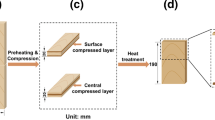Abstract
In order to increase its hardness and gravity as well as dimension stability, the technology of hot-compressing onPaulownia wood was studied. The main factors of affecting the spring back of the compressedPaulownia samples were discussed. It was discovered that every factor in the experiment had obvious effects on wood hardness and dimension stability of compressed wood. When the MC (Moisture Content) of experimental specimens was 13.89%, it was useful to spray water on the surface of samples before hot pressing. The best result was the recovery of compression set could decrease from 90.69% of untreated wood to 45.51% of soaking specimens into PF (Phenol Formaldehyde) water solution. The hot pressing time was 8 min at 190°C.
Similar content being viewed by others
References
Burmester, V.A. 1973. Effect of heat-pressure-treatments of semi-dry wood on its dimensional stability. Holz roh-Werkst,31:237–243
Chen Junqin. 1983. The properties and utilization ofPaulownia wood (I). Forestry Science,19(1):57–63
Chen Yuhe. 1993. The present situation and developing strand ofPaulownia wood utilization in Henan Province. The Forestry Science and Technology of Henan,1(39): 4–6
Giebeler, E. 1983. Dimensional stabilization of wood by moisture heat pressure treatment. Holz Roh-Werkst,41:87–94
Hillis, W.E. 1980. Some basic characteristics affecting wood quality. Appita,33(5):339–344
Hillis, W.E. 1984. High temperature and chemical effects on wood stability. Wood Science and Technology,18:281–293
Hillis, W.E. and Rozsa, A.N. 1987. The softening temperatures of wood. Holz forschung,32:68–73
Inoue, M., Norimoto, M. and Tanahashi, M.et al. 1993. Steam or heat fixation of compressed wood. Wood and fiber Science,25(3):224–235
Inoue, M., Norimoto, Y. and Otsuka, Y.et al. 1991. Surface compression of coniferous wood lumber II: Permanent set of compression wood by low molecular weight phonemic resin and some physical properties of the products. Mokuzai Gakkaishi,35(3):227–233
Lu Wenda and Li Jan. 1993. Wood Modification Technology Harbin: Northeast Forestry University Press
Stamm, A.J., Burr, H.K. and Kline, A.A. 1946. Stabwood-A Heat stabilized wood. Ind. Eng. Chem.38(6):630–634
Zhu Zhaohua. 1981. The discussion on the distribution center and quxichenfen ofPaulownia Plant. Forestry Science,17(3):271–280
Author information
Authors and Affiliations
Additional information
Responsible editor: Zhu Hong
Rights and permissions
About this article
Cite this article
Yuhe, C., Muehl, J.H. Factors of affecting the spring back of compressedPaulownia wood. Journal of Forestry Research 10, 168–172 (1999). https://doi.org/10.1007/BF02855425
Received:
Issue Date:
DOI: https://doi.org/10.1007/BF02855425




